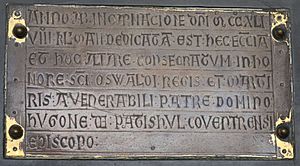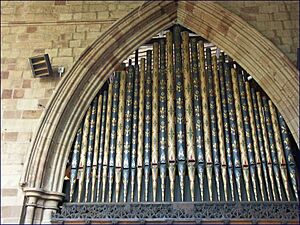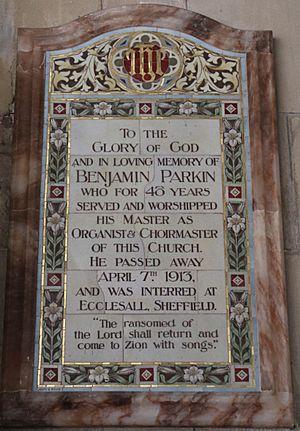St Oswald's Church, Ashbourne facts for kids
Quick facts for kids St Oswald's Church, Ashbourne |
|
|---|---|
 |
|
| 53°00′59″N 1°44′10″W / 53.01641°N 1.73612°W | |
| OS grid reference | SK 17628 46439 |
| Country | England |
| Denomination | Church of England |
| Churchmanship | Broad Church/Central |
| Website | Ashbourne Church |
| History | |
| Dedication | Oswald of Northumbria |
| Dedicated | 24 April 1241 |
| Architecture | |
| Heritage designation | Grade I listed building |
| Designated | 1240 |
| Architectural type | Perpendicular Gothic |
| Specifications | |
| Spire height | 212 feet (65 m) |
| Administration | |
| Parish | Ashbourne |
| Diocese | Diocese of Derby |
| Province | Canterbury |
St Oswald's Church is a beautiful old church in Ashbourne, England. It belongs to the Church of England. This church is a very important building in the town. It is known for its tall spire and amazing history.
Contents
History of St Oswald's Church
The church is named after Oswald of Northumbria, an ancient king. A special brass plaque inside the church tells us it was officially opened on April 24, 1241. This ceremony was led by Bishop Hugh de Pateshull. He was the Bishop of Coventry and Lichfield at that time.
Building the Church
Construction of the church likely began around 1240. It probably took many years to finish, possibly until the early 1300s. This church was built on the site of an even older Saxon church. There might have been a second Norman church there too. In 1913, during some digging, a Norman crypt (an underground room) was found.
The church's spire is 212 feet (about 65 meters) tall. It stands out in the town. A famous writer, George Eliot, once called it the "finest single spire in England."
Restorations and Changes
Over the years, the church has been repaired and updated. From 1837 to 1840, Lewis Nockalls Cottingham worked on it. Then, in the 1870s, George Gilbert Scott made more changes. He added decorative walls, called battlements, to the chancel (the part of the church near the altar).
For a long time, St Oswald's Church and Ashbourne Hall were the two main landmarks in town. Ashbourne Hall was a large house. Now, St Oswald's Church is the most important historical building in Ashbourne. It is also a Grade I listed building, which means it's a very important historic site.
Beautiful Stained Glass Windows
St Oswald's Church has many stunning stained glass windows. These windows tell stories and show beautiful pictures using colored glass.
The Turnbull Daughters' Window
One special window was made by Christopher Whall in 1905. It was given to the church by Mr. and Mrs. Peveril Turnbull. This window remembers their daughters who sadly died in a local fire.
This window has three main sections. It shows three saintly women: St. Cecilia, St. Monica, and St. Dorothea. St. Cecilia is shown falling asleep to heavenly music, which is a gentle way to show death. You can see girls playing an organ, dressed in old-fashioned clothes with flowers in their hair. In one part of the window, you can see a heavenly city through a thorny bush. Christopher Whall even put his own thumbprint on this window as his signature!
Important Memorials
Inside the church, there are special chapels. These chapels are dedicated to important local families. The north side has the Cockayne and Boothby family chapels. The Boothbys bought Ashbourne Hall in the 1700s. On the south side is the Bradbourne family chapel. These chapels hold many famous monuments.
The Boothby Monument
One monument is especially famous: the Boothby monument. It honors Penelope Boothby, the daughter of Sir Brooke Boothby. This sculpture is incredibly realistic. It is made from white Carrara marble from Italy. It shows a child sleeping peacefully.
This sculpture is considered the best work by the artist Thomas Banks. Penelope's father asked him to create it. The monument has words written on it in different languages. The English part says: "She was in form and intellect most exquisite. The unfortunate Parents ventured their all on this frail Bark. And the wreck was total." This means she was very beautiful and smart, and her parents were heartbroken by her loss.
Other memorials in the church remember many generations of the Boothby family. Sir Brooke Boothby was a poet. He wrote poems called "Sorrows Sacred to the Memory of Penelope" after his daughter died. These poems had pictures by artists like Fuseli. It is said that Sir Brooke never truly recovered from losing Penelope. He passed away in 1824.
The churchyard also has war graves. These are for two soldiers from World War I and an army officer from World War II.
-
The famous Boothby Monument.
The Church Organ
The church has a grand organ. A new organ was put in by Valentine of Leicester in 1710. Another organ was obtained in 1826 by a builder named Parsons. It was made bigger in 1840. The current organ was installed in 1858. It cost £800 at that time. Some parts of it might even be from an older 18th-century instrument.
The organ has been repaired and updated several times. Companies like Hill and Son, Hill, Norman and Beard, and Henry Groves & Son have worked on it. The last major work was done in 2011.
Organists and Music Directors
Many talented musicians have played the organ and directed music at St Oswald's. Some of the notable organists include:
- Edward Simms (from around 1797 to 1832)
- Andrew Loder (1834–38 and again around 1846–1859)
- Benjamin Parkin (from around 1856 to 1904), who served for a very long time.
- George Frederick Handel Kemp (from about 1906 to 1936)
- Chris Daly Atkinson (from around 1944 to 1992)
Cultural Connections
The bells of St Oswald's Church inspired a famous poem. The poet Thomas Moore lived nearby for four years. He wrote lines in his poem Lalla Rookh about the church bells:
Those evening bells! Those evening bells!
How many a tale their music tells
Of youth and home and that sweet time
When last I heard their soothing chime.
Those joyous hours are passed away:
And many a heart that then was gay
Within the tomb now darkly dwells
And hears no more those evening bells.
And so 'twill be when I am gone:
That tuneful peal will still ring on
While other bards shall walk these dells,
And sing your praise, sweet evening bells.
See also
- Grade I listed churches in Derbyshire
- Listed buildings in Ashbourne, Derbyshire












